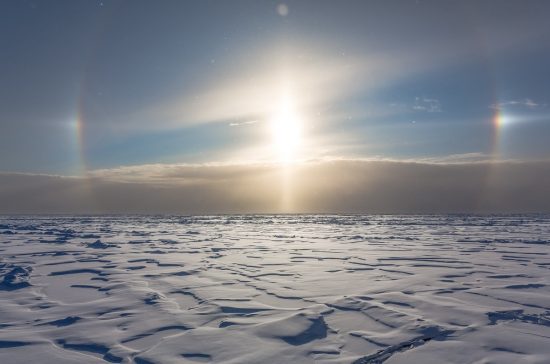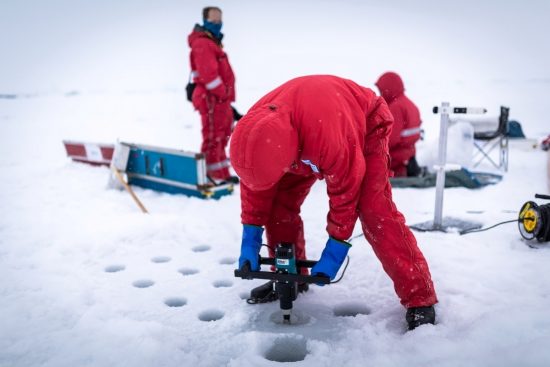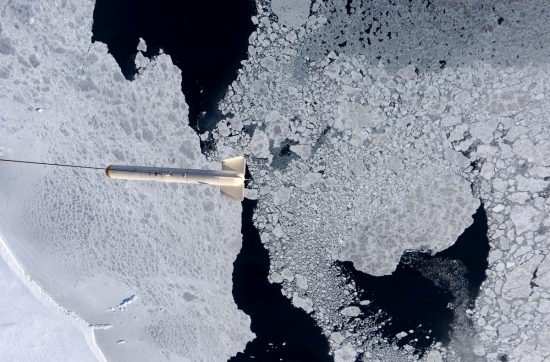




At
the Alfred Wegener Institute, Helmholtz Centre for Polar and Marine Research
(AWI), sea ice physicists have predicted that the sea ice cover in the Arctic
Ocean may shrink to the record low of 2012, after analysing satellite data
about the thickness of the ice cover.
According
to the data, the Arctic sea ice was already very thin during the summer of
2015. A very small amount of new ice had formed during the past winter due to
the particularly warm winter.
Sea
ice expert Dr Marcel Nicolaus presented these research results at the annual
meeting of the European Geosciences Union in Vienna on 21 April 2016.
Predicting
the extent of the Arctic sea ice several months in advance is not easy. This is
ultimately determined by wind conditions, and the air and water temperatures
during the summer months. However, the foundations would have been laid during
the preceding winter. This spring, they had been as bad as they were in 2012.
Back then, the Arctic sea ice surface had been at a record low of 3.4 million
square kilometres.
“If
we compare the ice thickness map of the previous winter with that of 2012, we
can see that the current ice conditions are similar to those of the spring of
2012 – in some places the ice is even thinner,” said Dr Nicolaus at a press
conference during the EGU General Assembly in Vienna.
He
and AWI colleague Dr Stefan Hendricks evaluated the sea ice thickness
measurements of the past five winters, as recorded by the CyroSat-2 satellite
to arrive at their projection. Additional data was acquired by seven autonomous
snow buoys that had been placed on floes last autumn. These buoys recorded the
thickness of the snow cover above the sea ice, the air temperature and air
pressure. Comparing this data against the long-term measurements taken by AWI
on board Spitsbergen showed that the temperature in the central Arctic
in February this year had exceeded the average temperatures by up to 8 degrees
Celsius.
Sea ice did not melt during winter but grew very slowly
This
warmth, however, did not lead to the thinning of the sea ice cover in certain
regions during the winter. Dr Nicolaus said that “according to our buoy data
from the spring, the warm winter air was not sufficient to melt the layer of
snow covering the sea ice, let alone the ice itself.” During the past winter,
the Arctic sea ice growth was significantly slower than what the scientists had
expected.
Arctic ocean currents carry much thick ice till autumn
Dr
Hendricks further explained that the Transpolar Drift Stream would carry the
majority of the thick, perennial ice that was currently off the northern coasts
of Greenland and Canada through the Fram Strait to the North Atlantic.
He
added that “these thick floes will then be followed by thin ice, which melts
faster in the summer. Everything suggests that the overall volume of the Arctic
sea ice will be decreasing considerably over the course of the coming summer.
If the weather conditions turn out to be unfavourable, we might even be facing
a new record low.”
The
amount of sea ice loss is expected to be so large that it would undo all the
growth recorded over the relatively cold winters of 2013 and 2014, according to
the AWI scientists. They observed a considerable decrease in the thickness of
the sea ice as early as the late summer of 2015, despite the fact that the
overall ice-covered area of the September minimum ultimately exceeded the
record low of 2012 by about one million square kilometres. The unusually warm
weather had led to the likely continuation of the Arctic sea ice decline in
2016.
If
you are interested to track the state of the Arctic and Antarctic sea ice, go
to this online portal. Here, you can also access the CryoSat-2 ice thickness maps and the data
gathered by the snow buoys.
Source:
www.awi.de
 Mares
Mares 19th May 2016
19th May 2016